Emerging Markets Rally: A Strong Contrast To The US Market Downturn

Table of Contents
Divergent Economic Fundamentals Fueling the Emerging Markets Rally
The emerging markets rally isn't a random occurrence; it's fueled by a divergence in economic fundamentals compared to developed markets like the US. Several key factors contribute to this robust growth.
Resilient Growth in Key Emerging Economies
Many emerging economies are demonstrating surprising resilience in the face of global headwinds.
- Strong domestic demand in India and China: Both countries are experiencing robust consumer spending, driven by a growing middle class and government infrastructure projects. India's GDP growth remains consistently strong, while China, despite facing challenges, continues to show significant growth in certain sectors.
- Infrastructure investments in Southeast Asia: Significant investments in infrastructure development across Southeast Asia are boosting economic activity and creating jobs, further fueling growth in the region. Countries like Vietnam and Indonesia are experiencing particularly strong growth.
- Recovery in tourism sectors in several emerging markets: The rebound in international travel has significantly benefited tourism-dependent economies, leading to increased employment and revenue generation in many emerging markets.
These positive trends are reflected in various economic indicators. For instance, the International Monetary Fund (IMF) projects strong GDP growth for several key emerging economies in 2024, exceeding growth rates in developed nations. This emerging market growth is a key driver of the current rally.
Commodity Price Boom Benefits Emerging Market Exporters
The surge in commodity prices is another significant factor contributing to the emerging markets rally. Many emerging economies are major exporters of raw materials.
- Increased demand for raw materials: Global demand for energy, metals, and agricultural products remains high, driving up prices.
- Higher prices for energy and metals: The ongoing energy transition and increased industrial activity are pushing up prices for oil, gas, and various metals.
- Impact on specific emerging market economies heavily reliant on commodity exports: Countries heavily reliant on commodity exports, such as those in Latin America and Africa, are experiencing significant economic benefits from this price boom.
The correlation between commodity prices and the performance of emerging market indices is undeniable. As commodity prices rise, so does the performance of many emerging market equities, further strengthening the rally. This emerging market commodities boom is directly contributing to the overall positive trend.
Relative Strength of Emerging Market Currencies
The relative strength of several emerging market currencies against the US dollar is another factor bolstering the rally.
Factors Contributing to Currency Appreciation
Several factors have contributed to the appreciation of certain emerging market currencies.
- Capital inflows due to higher interest rates: Higher interest rates in some emerging markets are attracting foreign investment, increasing demand for their currencies.
- Increased foreign direct investment: Growing confidence in the economic prospects of several emerging markets is leading to increased foreign direct investment, further supporting their currencies.
- Improved current account balances in select emerging markets: A strong current account balance indicates a healthy economy and contributes to currency stability and appreciation.
The interest rate differentials between emerging and developed markets play a crucial role. Investors seek higher yields, leading to capital inflows into emerging markets and boosting their currencies. This dynamic significantly impacts the foreign exchange markets.
Implications for Investors
The strength of emerging market currencies presents both opportunities and challenges for investors.
- Opportunities for diversification: Investing in emerging markets offers diversification benefits, reducing overall portfolio risk.
- Potential for higher returns: Emerging markets often offer higher potential returns compared to developed markets, though with higher risk.
- Increased volatility and associated risks: Emerging markets are inherently more volatile than developed markets, presenting increased risk.
Effective hedging strategies and risk management techniques are crucial for navigating the volatility of emerging market investments. Investors should carefully assess their risk tolerance before investing in this sector. Diversification within emerging markets is also crucial to mitigate specific country risks.
Challenges and Risks Associated with the Emerging Markets Rally
Despite the positive trends, several challenges and risks are associated with the emerging markets rally.
Geopolitical Instability and its Impact
Geopolitical instability poses a significant threat to emerging market growth.
- Regional conflicts: Ongoing conflicts and tensions in various regions can disrupt economic activity and investor confidence.
- Political uncertainty: Political instability and uncertainty can negatively impact investment flows and economic growth.
- Trade wars: Trade disputes and protectionist policies can harm emerging market economies heavily reliant on exports.
Geopolitical risk is a critical factor to consider when investing in emerging markets. Careful monitoring of geopolitical events is necessary to assess potential impacts on specific economies and investment strategies. The current global geopolitical climate introduces significant uncertainty for investors in this sector.
Inflationary Pressures and Monetary Policy Responses
Inflationary pressures present another significant challenge.
- Rising inflation rates in some emerging markets: Several emerging markets are experiencing rising inflation rates, eroding purchasing power and impacting economic growth.
- Central bank responses to inflation: Central banks in some emerging markets are raising interest rates to combat inflation, potentially slowing economic growth.
- Potential impact on economic growth: The interplay between inflation, interest rates, and economic growth is complex and can significantly impact the performance of emerging markets.
Monetary policy responses to inflation can have both positive and negative effects. While controlling inflation is crucial for long-term stability, aggressive interest rate hikes can stifle economic growth and negatively impact investor sentiment.
Conclusion
The emerging markets rally presents a compelling contrast to the downturn in the US market, driven by a confluence of factors including strong domestic demand, commodity price booms, and relative currency strength. While this offers exciting investment opportunities, investors must carefully consider the associated geopolitical risks and inflationary pressures. Understanding these dynamics is crucial for successfully navigating the current economic landscape. To learn more about capitalizing on the potential of the emerging markets rally, consult our expert resources on investing in emerging markets. Don't miss out on the opportunity to understand the current trends in the exciting world of emerging market investments.

Featured Posts
-
 Mahmoud Khalil Columbia Student Denied Leave To Witness Sons Birth By Ice
Apr 24, 2025
Mahmoud Khalil Columbia Student Denied Leave To Witness Sons Birth By Ice
Apr 24, 2025 -
 Selling Sunset Star Exposes La Landlord Price Gouging After Fires
Apr 24, 2025
Selling Sunset Star Exposes La Landlord Price Gouging After Fires
Apr 24, 2025 -
 Chinese Stocks In Hong Kong Surge Trade Tension Easing Fuels Rally
Apr 24, 2025
Chinese Stocks In Hong Kong Surge Trade Tension Easing Fuels Rally
Apr 24, 2025 -
 John Travoltas Heartfelt Tribute A Moving Photo Marks Jett Travoltas 33rd Birthday
Apr 24, 2025
John Travoltas Heartfelt Tribute A Moving Photo Marks Jett Travoltas 33rd Birthday
Apr 24, 2025 -
 The Impact Of Trumps Budget Cuts On Tornado Preparedness And Response
Apr 24, 2025
The Impact Of Trumps Budget Cuts On Tornado Preparedness And Response
Apr 24, 2025
